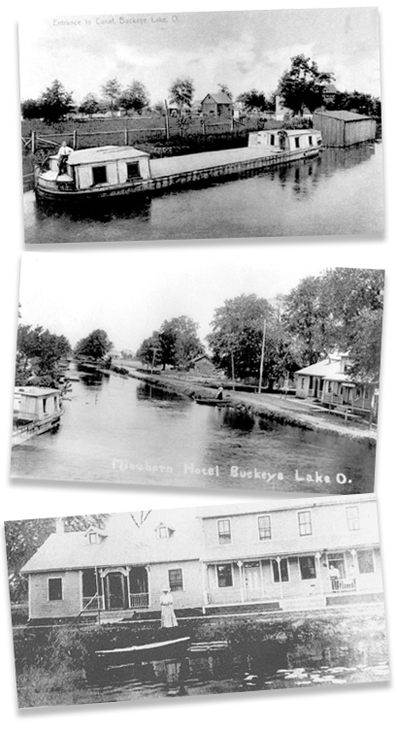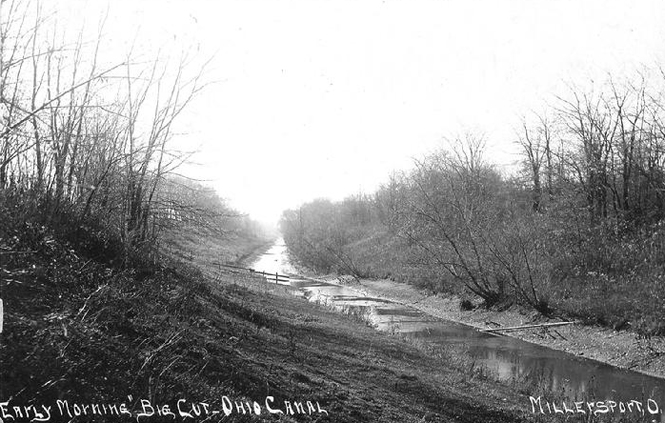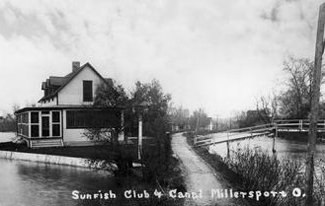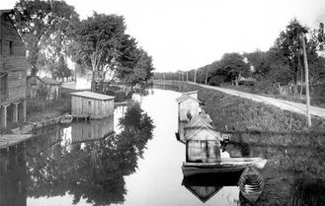 | |||||||||
| Home | A Brief History |
Amusement Park |
Bars & Dance Halls |
Photo Gallery |
Historical Events |
BLYC | Local Restaurant Guide |
Store | Contact Us |

The Ohio Canal

The Deep Cut was the greatest single obstacle to be overcome in constructing the Ohio and Erie Canal. To complete the canal to the south of the reservoir required mustering the best engineering knowledge of the day. To forge an opening through the Licking/Little Walnut divide required cutting through a ridge which, according to most records, was thirty-four feet deep at its maximum near the middle of the ridge. The ridge itself was nearly two miles in width. The Deep Cut is considered by some historians as one of the greatest engineering feats in Ohio's first half-century. The deep cut, which begins at the southwest corner of Buckeye Lake was a hand dug channel. Over five years were needed to complete this vast project. In 1830, the canal was opened from the Licking Summit Reservoir northward to Lake Erie. It was well into1832, however, before southward canal traffic could utilize the waterway, principally because of the length of time required to complete the Deep Cut. "This tremendous ditch"was over three miles long. Blasting through rock was not necessary, nonetheless the amount of earth removed was great indeed. Nearly a million cubic yards of dirt, shale, rock, clay--and whatever else the last glacier deposited in southern Licking and northern Fairfield Counties--were moved by hand mostly by Irish immigrant ditch diggers using shovels, wheelbarrows, wooden scoops behind horses or mules and crudely constructed ox-carts. Historical sources suggest that some of the contractors went bankrupt, malaria forced many of the workers to miss some much needed laboring days. The original contract for the Deep Cut, so it seems, called for completion of this mammoth engineering project in two years. But construction difficulties stretched this to six before the channel was capable of holding water and carrying boats through to the south.


The ridge was cut through from side to side permitting the canal to make its way south beyond the reservoir area and eventually snake westward to Baltimore, Canal Winchester and Lockbourne, south of present-day Columbus. The maximum depth of the cut vary widely in differing accounts of the construction project. These depths range from thirty-two to sixty- eight feet. Standing near the top of the Deep Cut today and looking down into this humanly fabricated canyon certainly gives evidence of a depth greater than thirty-two feet. The depth of the cut was increased due to the huge quantities of earth removed and hauled out of the freshly dug channel, which formed on the west the spoil bank.
Joseph Simpson writes almost poetically about his visits to the Deep Cut early in this century. He writes as follows:At present day the cut, with its high banks, presents a wild and picturesque scene. The utter stillness, the dark shadows cast by the tall tree and undergrowth, would surely furnish material for an artist. It has been so long out of use that with its trees and clustering vines, it looks weird and dark, and but for the farm house high on the opposite bank, one might enjoy all the solitude his heart would wish for. With its broad curving sides and water below, one could easily picture to himself another Colorado Canyon.
Unskilled laborers, primarily Irish immigrants, tirelessly dug the canal using picks, shovels, wheelbarrows, and oxen-cart.